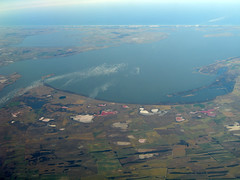In the last
couple of days, the Lock the Gate Alliance which represents a coalition of
landholders opposed to coal seam gas in the Surat Basin released a video called Condamine River Gas Leak. It shows footage from an organisation called
Gasileaks taken along the River at an “undisclosed location”. There was bubbling
activity at the surface of the river and some kind of meter that went berserk
when placed near the bubbles.
 |
| Frackman in Roma July 2010 |
It might be
difficult for Pratzky and other blockies in the Lock the Gate Alliance to do
exactly that. This is their life and they don’t want to move on. Yet I fear
they – and others who want a moratorium of the industry – are placing themselves
too far outside the conversation about how the industry should evolve. Origin Energy, the petroleum tenure holder in
the location where Pretsky filmed (a fishing spot south west of Chinchilla known
as the "coal hole") confirmed what Thomas told the Western Star on Facebook “According to local knowledge it
goes back at least 30 years and naturally occurring gas has been a phenomenon
in the Queensland Western Downs region for more than 100 years,” Origin said.
The public face
of Lock the Gate Alliance is its media-savvy president Drew Hutton. He was the one who
publicly announced the Chinchilla leak. Hutton, a prominent member of Queensland
Greens, said he was unconvinced by Origin’s response and challenged them to prove
it. Hutton said Origin should “release its seismic and other data...to
establish whether or not the leak is linked to the company's coal seam gas operations.”
Hutton said he consulted “several highly competent hydrogeologists” who told
him there was a good chance the leaks were “linked to the de-watering of the
coal seam aquifers and possibly fracking opening up pathways for the methane.”
With neither
Origin nor Hutton willing to offer their sources, it is difficult to know who
is right. And water quality remains one of the great unknowns of this massive
new industry. Yet this problem can be solved just as land access
and now water depletion. The 2010 Queensland land access laws redressed the power imbalance between gas
companies and landholders and the new Draft Surat Basin Underground Water Impact Report which I reported about on Monday (Part 1) and Tuesday (part 2) deals with the water depletion issue. The report
specifically ruled out a role for monitoring water quality. That prompted an anonymous
respondent to my Tuesday piece to ask the legitimate question: if "It will
not monitor water quality (eg for contamination from fracking)", who WILL
monitor water quality?
The answer
to that question is the same as the answer to who will monitor water depletion:
a mix of the Queensland Government Department of
Natural Resources and Mining and the petroleum tenure holders themselves. Many
in the Roma forum on the report I attended asked if this was not leaving the
fox in the charge of the henhouse. The Queensland Water Commission’s response
to that was to say, if they did something wrong, they’d be found out. There
would be anomalies in the results that would stand out.
If this is
correct then we need to maintain trust. Trust of the companies to do the right
thing and trust of the regulator to pick up the anomalies if the companies don’t
do the right thing. The gas majors all have the profit imperative but are
bound by a number of strict rules and environment conditions they have to satisfy to get the green light for their enterprises. With the
pressure to meet their export commitments once the gas comes online in 2014,
those companies will need to ensure they are squeaky clean so the regulator does
not have a reason to hold them up.
What does
need to be looked at is the quick gobbling up of Australia’s natural resources.
According to mining critic Paul Cleary,
Australia has the 12th largest reserve of gas but is the world’s
second largest exporter and heading towards number one. Gladstone Port in Queensland is the home of four of
the eight big LNG plants and Incentives by the Bligh Government drove gas consumption
for the local market. Now the high price of oil is driving this massive
investment in coal seam methane for LNG. The problem is the price of natural
gas on the New York-based Henry Hub has
been declining for over a year and will mean the companies will have to
reforecast earnings or else dig for more gas.
With
governments greedy for the royalties, knowing when that saturation point comes
will be critical for the success of the industry and the regions they serve. As
the Surat DWIR proves, having good legislation supported by science will be
critical in keeping an even keel.




















